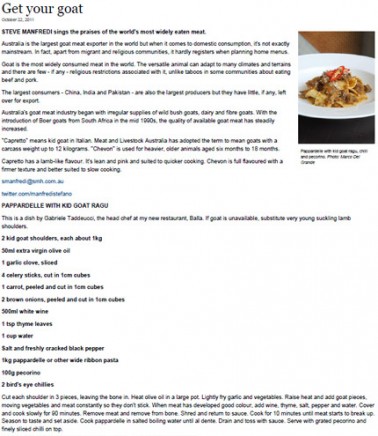
MORE SEASONAL RECIPES
-
24 Jun 19
-
11 Feb 19
-
10 May 18
-
14 Jun 16
-
10 Jul 15
-
10 Jul 15
-
24 Oct 14
-
23 Oct 14
Steve Manfredi
While Australia is the largest goat meat exporter in the world, when it comes to domestic consumption it’s not mainstream. In fact, apart from migrant and religious communities, goat barely registers a thought when it comes to planning a home menu.
Goat meat is the most widely consumed meat in the world. It’s a versatile animal that can adapt to many climates and terrains and there are few, if any, religious restrictions associated with eating it unlike taboos in some communities with eating beef and pork.
The largest consumers- China, India and Pakistan- are also the largest producers but they have little, if any, left over for export.
Australia’s goat meat industry began with irregular supplies of wild bush goats, dairy and fibre goats. With the introduction of Boer goats from South Africa in the mid 1990s, the quality of goat meat available has steadily increased.
There are two terms to familiarise when it comes to goat meat. “Capretto” is kid goat in Italian and Meat and Livestock Australia (MLA) have adopted the term to mean goats with a carcass weight up to 12kg. “Chevon” is used for heavier, older animals aged 6-18 months.
Capretto has a lamb-like flavour; it’s lean and pink in colour and suited to quicker cooking. Chevon is fuller-flavoured and firmer
twitter.com/manfredistefano
PAPPARDELLE WITH KID GOAT RAGÙ
This is a dish by head chef Gabriele Taddeucci at my new restaurant, Balla. If goat is not available then substitute very young suckling lamb shoulders.
- 2 kid goat shoulders, each about 1kg
- 50ml extra virgin olive oil
- 4 celery sticks, cut in 1cm dice
- 1 carrot, peeled and cut in 1cm dice
- 2 brown onions, peeled and cut in 1cm dice
- 1 garlic clove, sliced
- 1 tsp thyme leaves
- 500ml white wine
- Salt
- Freshly cracked black pepper
- 1kg pappardelle pasta- or any wide-ribbon type
- 100g pecorino, grated
- 2 hot red chillies, finely sliced
Cut each shoulder in 3 pieces, leaving the bone in. In a large pot heat olive oil and lightly fry all the diced vegetables. Turn heat up a little and add goat pieces, moving vegetables and meat constantly so they don’t stick. When the meat has developed good colour add wine, thyme, salt, black pepper and then 1 glass of water. Cover and cook slowly for 90 minutes. Remove meat and take off the bone. Shred and return to the sauce. Cook for 10 mins more till the meat starts to break up. Check for seasoning and set aside. Cook pappardelle in salted boiling water till al dente. Drain and toss with sauce. Serve with grated pecorino and sliced chilli on top. Serves 8 as a first course.
Wine: Chianti Classico or Sangiovese
KID GOAT BRAISED WITH CAPSICUM
- 1kg kid goat meat from legs and shoulders, cut into bite-sized pieces
- 2 red capsicum, trimmed and cut into 1cm slices top to bottom
- 4 medium-sized ripe tomatoes, chopped
- 1 clove garlic, peeled and sliced
- 3 bay leaves
- 1 red chilli, minced
- 200ml dry white wine
- 1 tsp oregano, chopped
- 100ml extra virgin olive oil
- salt
Heat olive oil in a braising pan. Add garlic, bay leaves and chilli as well as goat pieces. Gently fry for 10-12 minutes until well browned. Add wine and stir well until liquid has all but gone. Add capsicum and stir well until capsicum has wilted a little. Add chopped tomatoes, oregano and a couple of good pinches of salt. Stir well and simmer for 15 minutes until goat is tender. Cook a little longer if needed. Once cooked, remove from heat and let sit for 10 minutes. Serve with bread and salad. Serves 4 as a main course.
Wine: Dolcetto, either Australian or Italian.